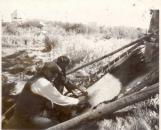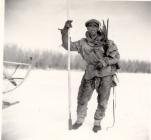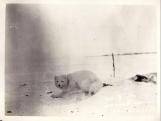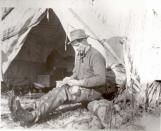1
Images of trapping and the fur trade resonate as pictures of the North - of men with huge piles of furs, of women cleaning and stretching the skins, of the trapper who looks like he has spent months alone in the bush. The fur trade is the oldest industry in Northern Manitoba, and continued to be a big business in the early 1900s. In 1914 alone the fur trade in The Pas was valued at approximately $250,000.The Pas has always been a stopping point for furs headed for distribution around the world. However, by the 1900s no longer were furs going north to York Factory and Churchill via the Saskatchewan River. The coming of railroad service to The Pas in 1908 meant that furs were now being sent south to Winnipeg.
2
Four trappers with furs.c. 1920s
Northern Manitoba
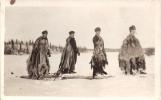 Credits:
Credits:E.S. Barker & E.M. (Coan) Barker Collection
PP2011.5.211
3
A community member at work on animal skins.1923-1930
Moose Fort, James Bay (Moose Factory, Ontario)
 Credits:
Credits:Sam Waller?
PP84.192.192
4
A community member at work on animal skins.1923-1930
Moose Fort, James Bay (Moose Factory, Ontario)
 Credits:
Credits:Sam Waller?
PP84.192.193a
7
A man standing in front of many furs hanging on a line attached to trees.c. 1920s
Northern Manitoba
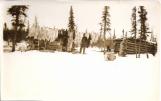 Credits:
Credits:E.S. Barker & E.M. (Coan) Barker Collection
PP2011.5.208
8
Trapper presenting a wolf pelt.c. 1920s
Northern Manitoba
 Credits:
Credits:E.S. Barker & E.M. (Coan) Barker Collection
PP2011.5.212
10
Variety of furs hanging from the side of a trapper's cabin.1920s
Northern Manitoba
 Credits:
Credits:Rose, Percy
PP2003.8.22
11
Muskrat ranches were first established in the late 1930s as a conservation measure. Years of indiscriminate trapping and unethical practices by white trappers, like the use of poisoned bait, had caused a sharp decrease in muskrat pelts. In 1902, 600,000 muskrat pelts were trapped in this region, but by 1930 the number had dropped to 10,000 pelts. (The Pasquia Land Settlement Project Interim Report No. 1)Tom Lamb, the "Muskrat King," pioneered muskrat ranching with the development of the Summerberry Fur Rehabilitation Block east of The Pas. Through a series of irrigation ditches, he was able to control water levels to prevent dry marshes. Muskrats thrived, and trappers were provided a steady income - attracting hundreds of men to go work the muskrat ranches.
12
Muskrat ranchers enroute to Tom Lamb's muskrat ranch being pulled on a barge by the "Skippy L".20th Century
The Pas, Manitoba
 Credits:
Credits:PP93.18.467
13
Muskrat hunters enroute to trapping area at Lamb Ranch.1941
The Pas, Manitoba
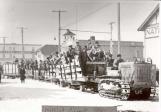 Credits:
Credits:PP93.18.468
